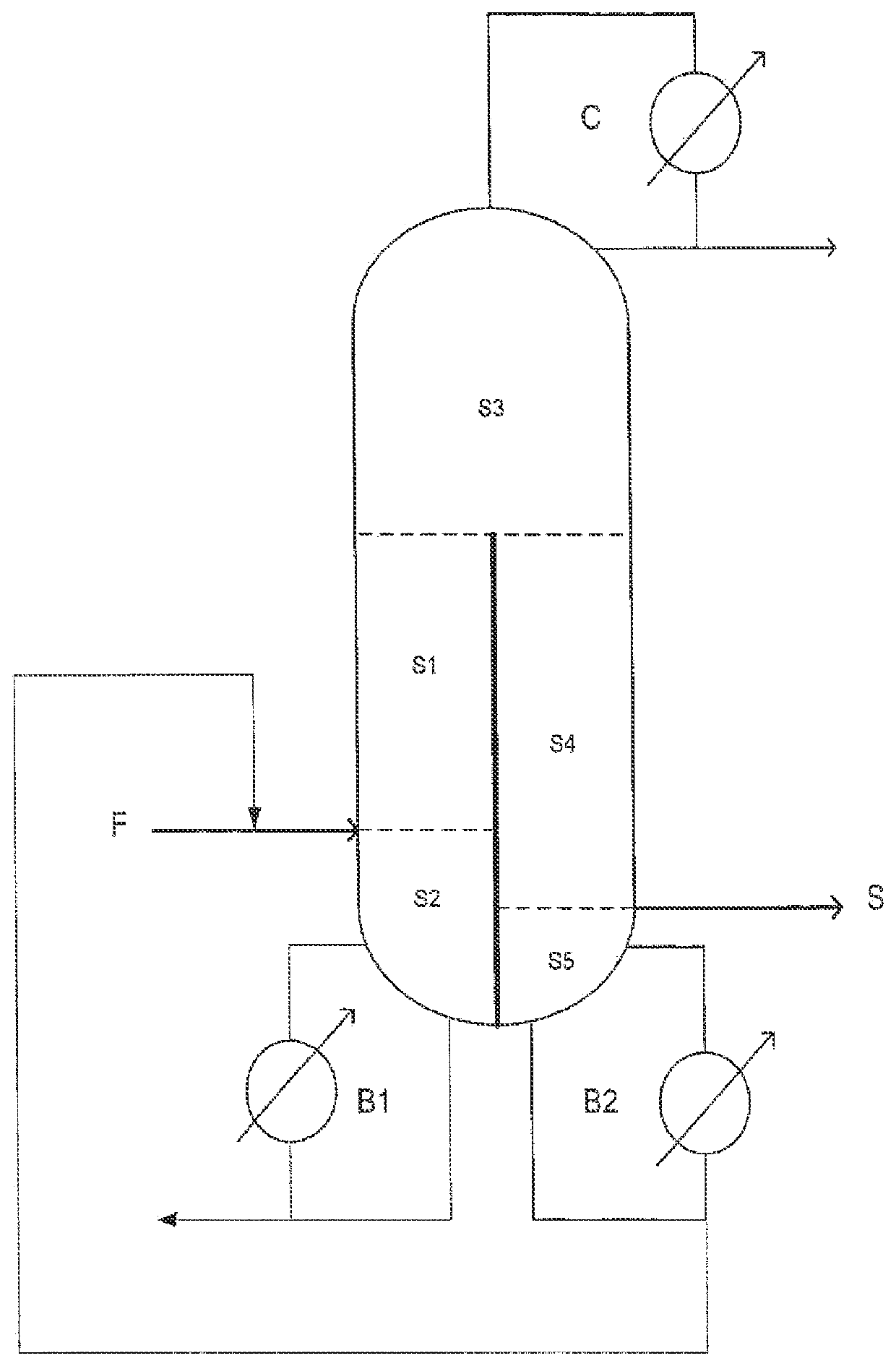Method for purifying (meth)acrylic esters
a technology of acrylic esters and purification methods, which is applied in the direction of chemical apparatus and processes, separation processes, organic chemistry, etc., can solve the problems of high capital cost, complex process, and high energy and capital cost of industrial plants, and achieves high energy and capital cost. cost, the effect of reducing the cost of capital cos
- Summary
- Abstract
- Description
- Claims
- Application Information
AI Technical Summary
Benefits of technology
Problems solved by technology
Method used
Image
Examples
example 2 (comparative)
stillation Columns in Series and Sidestream Withdrawal of the Purified Product
[0111]A crude DAMEA reaction mixture resulting from the synthesis by transesterification of ethyl acrylate and dimethylaminoethanol was subjected to a purification treatment using two distillation columns in series.
[0112]The first column comprises an equivalent, in theoretical stages, of 9 and it is combined at the bottom with a boiler and at the top with a condenser in which an organic phase is recycled partly in the column in order to provide the column with a reflux. The column is stabilized by injection of PTZ at the top condenser. The energy supplied by the boiler is 0.74 MW.
[0113]The second column comprises an equivalent, in theoretical stages, of 16 and it is combined at the bottom with a boiler and at the top with a condenser. It is fed by the bottom stream from the first column, which comprises the DAMEA, and also the light products (EA, DMAE) and heavy byproducts, such as the Michael adducts. The...
example 3 (
According to the Invention)
[0123]An ASPEN simulation using a thermodynamic model was carried out on the crude DAMEA reaction mixture, as described in examples 1 and 2, but subjected to a purification using the purification system as represented in the FIGURE.
[0124]In this example, the divided wall column is stabilized at the top condenser with PTZ and the DAMEA withdrawn as a sidestream in the gas phase is stabilized with HQME.
[0125]In this configuration, the number of plates of the different sections is as follows:[0126]N1: 8—N2: 6—N3: 5—N4: 10—N5: 1.
[0127]The energy supplied by the boiler is 1.4 MW.
[0128]The purified product withdrawn as a sidestream has the following composition by weight:[0129]DAMEA: 99.8%—DMAE: traces[0130]AAP traces—AEP: 237 ppm—EEP: 919 ppm—heavy products, including AEP: 254 pm[0131]Total stream: 2870 kg / h—temperature: 110° C.—pressure: 0.118 bar
[0132]In this configuration, the DAMEA is recovered with a yield of the order of 88%, with respect to the feed stre...
example 4
on of the Bottom Product During the Distillation
[0136]The aim of this example is to show the importance of the positioning of the separating wall in the divided wall column for the quality of the product obtained in sidestream withdrawal, in particular the need to have a wall separating the bottom part of the column.
[0137]We used a laboratory assembly composed of a stirred reactor, of a distillation column and of an oil bath which makes it possible to heat the product to the desired temperature.
[0138]A mixture having a composition close to the composition expected at the bottom of the distillation column at the boiler B1 was introduced into the reactor and subjected to a temperature of 140° C. at P atm for 3 hours.
[0139]The distillate collected at the top of the distillation column and the distillation bottom product were subsequently analyzed.
[0140]The amounts by weight of the light products distilled, in comparison with the amounts present in the mixture introduced into the reacto...
PUM
| Property | Measurement | Unit |
|---|---|---|
| pressure | aaaaa | aaaaa |
| temperature | aaaaa | aaaaa |
| temperature | aaaaa | aaaaa |
Abstract
Description
Claims
Application Information
 Login to View More
Login to View More - R&D
- Intellectual Property
- Life Sciences
- Materials
- Tech Scout
- Unparalleled Data Quality
- Higher Quality Content
- 60% Fewer Hallucinations
Browse by: Latest US Patents, China's latest patents, Technical Efficacy Thesaurus, Application Domain, Technology Topic, Popular Technical Reports.
© 2025 PatSnap. All rights reserved.Legal|Privacy policy|Modern Slavery Act Transparency Statement|Sitemap|About US| Contact US: help@patsnap.com

